The most delicious variety, suitable for long-term storage and consumption raw, is the “Marina from Chioggia” pumpkin.
The Marina from Chioggia pumpkin variety was developed in Italy. At home, it is one of the most popular products among culinary experts and is grown in large quantities by farmers in the north of the country.
These pumpkins appeared in Russia recently and have already become popular. Their undoubted advantages include high yield, rich sweet taste, bright appearance, ability to be stored for up to one and a half years. In this article we will look at what else is good about this variety and how to grow it correctly.
Description of the variety
The variety is medium late, technical ripeness occurs 90 days after planting. Full maturity, when the pumpkin reaches its maximum taste, occurs after 120 days.
The plant is powerful and climbing. Marina from Chioggia loves fertilizers and abundant watering, but bears fruit without them, being content with a minimum of moisture.
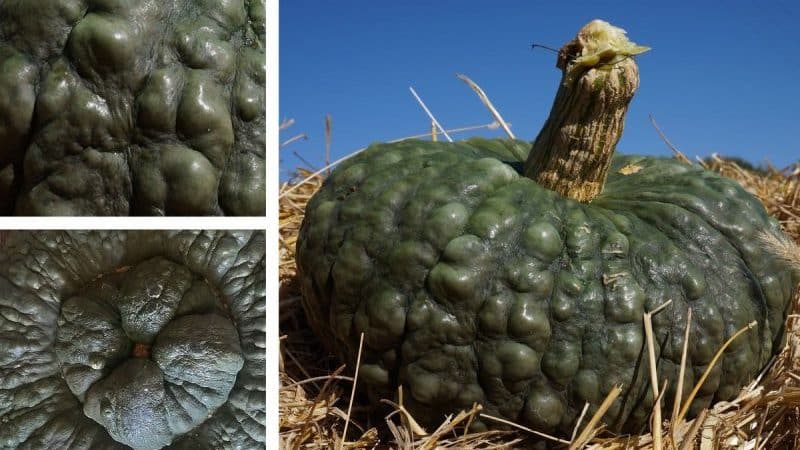
Distinctive features
In their homeland, Italy, pumpkins of this variety grow large, up to 10 kg. In Russia, the fruits reach a weight of 3-4 kg, retaining all the distinctive features: dark olive color, wrinkles, deep folds, knobbiness.
Fruit characteristics
The fruits have the correct shape, they are round and flat. Sometimes turban-shaped pumpkins grow, which makes them even more colorful.
Interesting. Initially, the pumpkins are round and smooth, but as they ripen, characteristic deep grooves and warts appear on them.
A ripe pumpkin is gray to blue-green or dark green in color and is entirely covered in bumps and warts. It contains few seeds - you can find 15-20 in a tiny seed chamber.
The pulp has a slight taste of tropical fruits and a honey aroma.
Productivity
One plant can bear 1-2 fruits weighing from 3 to 12 kg. Productivity depends on the amount of available moisture, heat and sun. Timely pollination of flowers is also important.
How to grow
Marina from Chioggia is planted either with seeds directly in open ground or with the help of seedlings. The planting method is chosen depending on the climate of the area where the pumpkin is grown. The fruits ripen late and will take a long time to reach frost. If September is warm in your area, it is better to plant pumpkin seeds at the end of May; if not, then seedlings in April.
Planting by seeds
When planting pumpkin seeds, planted in open ground, ripen no earlier than the end of August. Ideally, they will need another 2-3 weeks to reach their size and taste - this is subject to warm summers.
It is better to plant a pumpkin on an old compost or manure heap - this way the pumpkins will receive the maximum nutrients from the soil. The main thing is to water them more often, since such soil absorbs a lot of moisture.
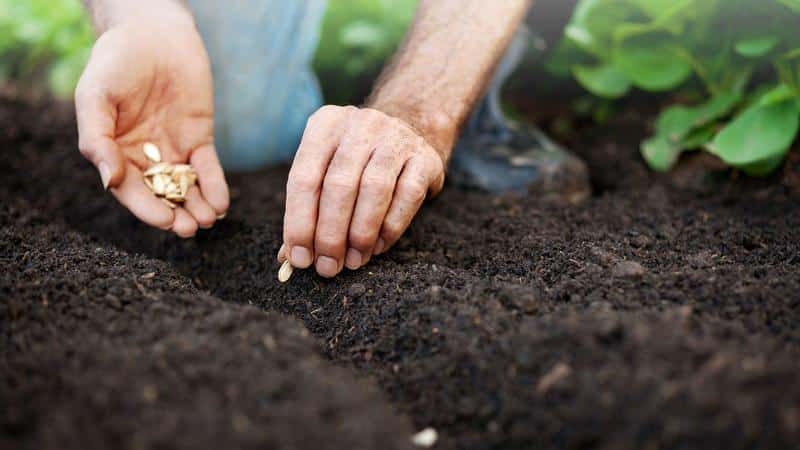
Seeds are prepared for planting in several stages:
- First, in a saline solution of 3 tbsp. l. table salt and 1 liter of water, soak the seeds for 5 minutes. After mixing, viable specimens will sink to the bottom - they are washed with clean water and dried. Those that float to the surface are thrown away.
- Then they are heated for 2-3 hours, gradually increasing the temperature to +60 °C.
- Before planting, the seeds are soaked for 10 hours in a nutritious infusion of wood ash (2 tablespoons per 1 liter of warm water).
- In order for seedlings to appear as early as possible, it is recommended to germinate the seeds. To do this, place a damp napkin on a saucer and wrap the seeds in it, keep them at room temperature until they bite, regularly moistening the napkin.
- Next, the germinated seeds should be hardened. To do this, they are placed in a damp cloth on the bottom shelf of the refrigerator for 12-18 hours, then taken out for 6-8 hours - and so on for a week.
- Seeds are planted when the soil at a depth of 12 cm warms up to +10 °C. Plant 2-3 seeds in a hole 5-10 cm deep (then you will need to select one and cut off the rest). 1 liter of warm water is poured into the hole.
- After planting the seeds until they emerge, they are protected with covering material.
Planting seedlings
The seeds are soaked, germinated and hardened in the same way as before planting directly into the ground.
Then do the following:
- Prepare the nutritional mixture: 5 parts decomposed peat + 3 parts manure humus + 1 part turf soil + 1 part mullein.
- The mixture is moistened and placed in containers measuring 10x10x10 cm. Sow one seed to a depth of 3 cm and water a little with warm water. Cover with film or glass. Grow at night temperatures +15-17 °C and daytime temperatures +20-25 °C, until germination. Next, the seedlings are grown on the windowsill at room temperature. A week before planting, it needs to be hardened: to do this, reduce the temperature to +15-18 °C during the day and +12-14 °C at night.
- The first feeding is done after two weeks solution 1 tsp. superphosphate + 0.5 tsp. urea per 1 liter of water. Norm: 1 cup per 2 plants. The second - after another two weeks with a solution of 1 tsp. nitrophoska + 1 tsp. wood ash per liter of water.
- The seedling is ready for planting when it has 2-3 true leaves. Plants are deepened into holes up to the cotyledons, watered with warm water and shaded for several days so that they take root better.
Care
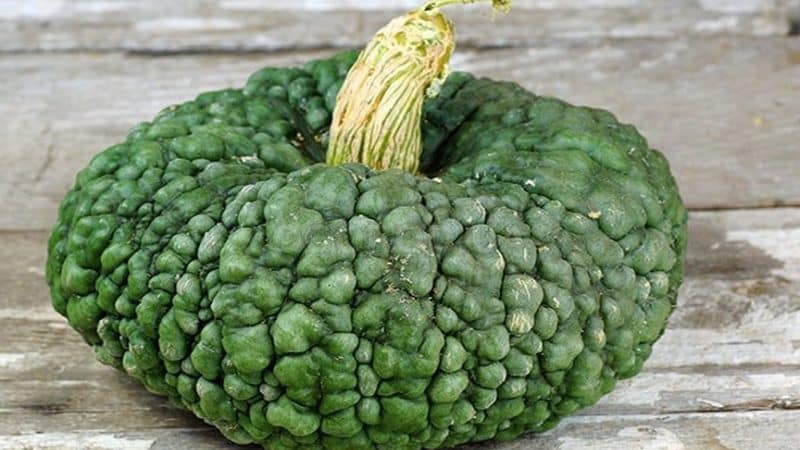
Caring for a pumpkin is not difficult if you take care of preparing the soil in advance. You can prepare it in two ways:
- Apply organic and phosphorus-potassium fertilizers during digging in the fall, then nitrogen fertilizers in the spring.
- In the spring, when digging, add a nutrient mixture at the rate of 2 buckets of humus, half a bucket of sawdust, 1 tbsp. nitrophoska and 1 liter of wood ash on the day of planting or the day before it.
Important! On heavy clay soils, it is better to grow pumpkins in beds.
Further care:
- Loosen the soil for better root formation until the plant has five full leaves.
- Water infrequently, but abundantly, during the growth period of green mass and fruits. Reduce watering during the flowering period.
- Feed every two weeks with mullein infusion.
- Weed the garden bed in a timely manner.
- Manually pollinate female flowers: pick a few male flowers, tear off their petals and pass the anthers along the stigma of the female flower. Repeat several times.
- To prevent the plant from wasting energy on the fruits, leave 2-3 lashes. They are pinched when the number of large (15-17 cm) ovaries reaches 2-5 pieces, leaving at least 5 leaves above each.
Important! In wet weather the fruits may rot. For prevention, place a plastic board under them.
Features of cultivation and possible difficulties
The main problem with growing Marina Chioggia pumpkin is its late ripening. When planted late, the fruits do not have time to ripen, so it is recommended to strictly adhere to the timing when growing: planting seeds for seedlings in April, planting seeds in open ground at the end of May.
There are more chances to grow a good harvest in the southern regions. For northern varieties, early-ripening, quickly ripening varieties are suitable.
Growing tips from experienced gardeners
For full growth, Marina from Chioggia requires a lot of free space, since her bushes are large and the vines spread over a distance of more than 5 m.
For the same reason, experienced gardeners advise regularly fertilizing pumpkins of this variety and providing the bushes with sufficient moisture.
Diseases and pests
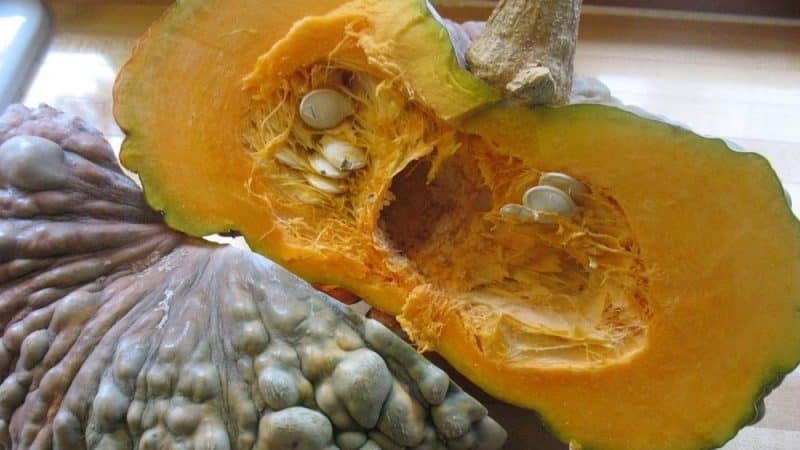
Pumpkins are unpretentious; they are immune to phytoinfections. However, there are diseases that can affect plants:
- Powdery mildew. A fungal disease that appears as white spots on the surface of the leaves. Treated with sodium phosphate.
- Bacteriosis. Associated with high air and soil humidity. It appears as light green spots on the leaves, which soon darken, dry out and leave holes. Treated with Bordeaux mixture.
- Root rot. A fungal infectious disease that affects the root collar. Associated with sudden changes in temperature and watering with too cold water. At the first signs, you need to change the layer of soil at the roots to a fresh one and treat the root collar with ash or crushed coal.
Pests that attack pumpkins most often:
- spider mite;
- melon aphid;
- slugs
Aphids and spider mites are fought with garlic infusion; slugs are destroyed mechanically or with the preparations “Mega” and “Groza”.
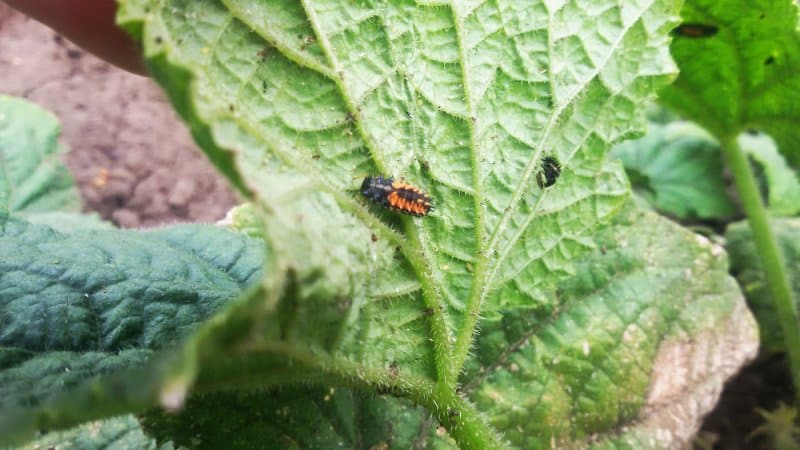
Harvesting and application
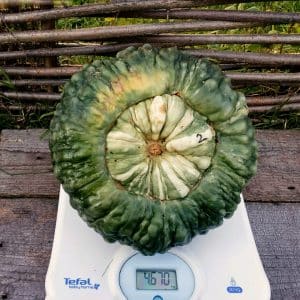
Harvesting is carried out no earlier than the end of September, before frost, in dry weather. Before sending for storage, the pumpkin is left to rest for 1-2 weeks in a moderately warm room. Remove the fruits carefully, leaving at least 10 cm of the stalk.
For storage Ripe specimens with intact thick skin are suitable. It is better to send thin-skinned fruits that are not fully ripe for processing or animal feed.
Pumpkins of this variety are perfectly stored - they can last up to one and a half years without losing their taste. When stored, the amount of sugar in them increases, and the color of the peel gradually changes to orange.
Sweet variety, good for cooking desserts.
Important! The peculiarity of the variety is its small but tasty seeds.
Advantages and disadvantages of the variety
The advantages of the variety include:
- spectacular appearance;
- high sugar content;
- absence of a “swampy” smell in ripe fruits;
- The variety is suitable for storage.
Flaws:
- long ripening;
- it is inconvenient to clean the warty peel;
- It is difficult to remove soil from the pits and furrows of the fruit, making cooking with the skin difficult.
Farmer reviews
Reviews about pumpkin vary, but mostly summer residents speak positively about it.
Natalia, Smolensk: “I grew pumpkins of the Marina variety from Chioggia in 2017. I started germinating seeds at the end of April. The seedlings were grown in a greenhouse. I planted it in the ground at the end of May. Until the end of June I kept it under covering material. There were a lot of flowers and ovaries, so I left two per vine. The harvest was harvested in mid-September, each bush produced 3-4 pumpkins.”
Roman, Tver: “We grow pumpkins every year for ourselves and for sale. Marina from Chioggia pleased with the harvest and the whole family liked it. I sold several pumpkins at the fall fair. In May, we planted the germinated seeds on an old manure heap, the bushes grew and bloomed in July. I sprayed the flowers with diluted honey to attract bees. July was dry, so I watered it every three days. The harvest was collected in September, the pumpkins grew large and sweet.”
Conclusion
With due diligence and compliance with the necessary growing conditions, every summer resident will be able to obtain a harvest of original fruits. These pumpkins will please the eye, become the object of admiration for your neighbors, and you will enjoy sweet, healthy desserts made from them throughout the year.